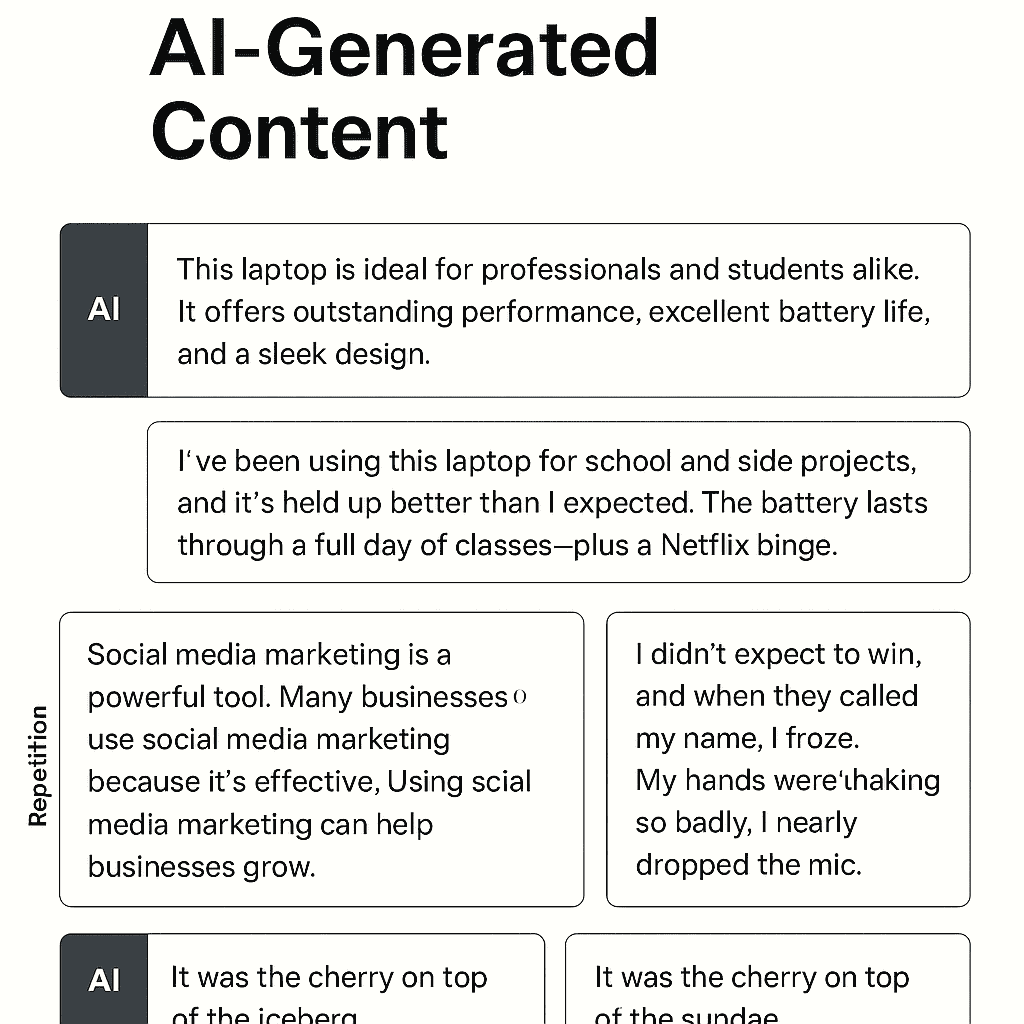How to Spot AI-Generated Content: A Practical Guide for the Curious Reader
How to Spot AI-Generated Content, AI has come a long way in recent years—so far, in fact, that it’s becoming genuinely difficult to tell the difference between something written by a person and something created by a machine. Whether you’re a teacher checking student essays, a marketer evaluating content, or just a curious internet user, it’s worth knowing how to spot the difference.
Thank you for reading this article, if you find it interesting don't forget to share!
This guide will walk you through the subtle (and sometimes not-so-subtle) clues that give away AI-generated content, along with some practical tools and examples to help you get better at spotting it.
What Is AI-Generated Content, Really?
Before we dive into the details, let’s clarify what we mean by “AI-generated content.” We’re talking about writing—emails, blog posts, social media captions, product descriptions, even entire books—that was produced by machine learning models like OpenAI’s ChatGPT, Google’s Gemini, or Anthropic’s Claude.
These tools are trained on vast datasets and can imitate many writing styles. They’re fast, fluent, and often factually accurate. But they’re still machines. And like all machines, they leave fingerprints.
1. The Language Is a Little Too Perfect
One of the first things you might notice is that AI-generated writing often sounds polished—but not in a good way. It’s smooth, sure, but it lacks any texture. The sentences might be grammatically perfect, but they read like they were pulled from a style guide rather than a lived experience.
Let’s say you’re reading a product review:
“This laptop is ideal for professionals and students alike. It offers outstanding performance, excellent battery life, and a sleek design.”
That might sound okay. But it also sounds like it came from a spec sheet, not a real person. Now compare that to:
“I’ve been using this laptop for school and side projects, and it’s held up better than I expected. The battery lasts through a full day of classes—plus a Netflix binge.”
The second version has flavor. It has fingerprints. AI writing, for now, usually doesn’t.
2. It Struggles with Specifics
Another big giveaway? AI writing tends to live in the realm of generalities.
You’ll see vague phrases like “people enjoy many benefits from…” or “this is a great solution for everyday needs.” That’s because, unless it’s given specific input, the model is pulling from an enormous average of everything it’s read. So unless someone has fine-tuned it with real experiences or detail, it’ll speak in generalizations.
Humans, on the other hand, draw on memory—what they saw, heard, felt. That makes our writing more grounded.
A human says:
“When I landed in Hanoi, the air was thick with humidity and the scent of street food. I got scammed at the airport and laughed about it later over pho.”
An AI might say:
“Vietnam is a popular travel destination known for its vibrant culture and delicious cuisine.”
Can you spot the difference?
3. Repetition and Redundancy
AI often loops or rephrases itself in weird ways. It’s a side effect of the way models predict text: they sometimes err on the side of caution and restate ideas to “stay on track.”
You might see something like:
“Social media marketing is a powerful tool. Many businesses use social media marketing because it’s effective. Using social media marketing can help businesses grow.”
That kind of robotic repetition is a classic AI tell. Humans get bored repeating themselves. Machines don’t.
4. The Tone Feels… Flat
AI can mimic tone, but it doesn’t feel tone. So while it can be upbeat, professional, casual, or clever, the emotion often lacks weight. It’s like an actor who knows the lines but not the meaning behind them.
Even when it tries to write something heartfelt, it usually ends up sounding generic:
“I was very happy to be given the opportunity. It was a great experience I will never forget.”
A human might write:
“I didn’t expect to win, and when they called my name, I froze. My hands were shaking so badly, I nearly dropped the mic.”
Emotion is in the details, not just the words. AI hasn’t quite nailed that.
5. Weird Metaphors, Botched Idioms
AI is trained on billions of words, but it doesn’t always understand nuance. That’s why you’ll sometimes see:
“It was the cherry on top of the iceberg.”
“They didn’t want to open that can of bees.”
These errors happen because AI tries to mimic human creativity by remixing phrases it’s seen before. But it doesn’t always get the cultural or contextual nuance right. Humans rarely mangle idioms like this—unless we’re doing it on purpose.
Bonus: How to Use AI Detection Tools (With Caution)
There are some solid AI detection tools out there:
- GPTZero – Good for educational content
- Originality.ai – Popular among content marketers
- Writer.com’s AI Content Detector – Free and lightweight
But take these tools with a grain of salt. They’re helpful, but not perfect. A human editor can outwrite detection, and an AI model can learn to “sound” more human. Use these tools as guides, not gospel.
Real-World Applications: Why This Matters
This isn’t just an academic exercise. Spotting AI-generated content has real implications:
- In journalism, verifying authorship and sources is critical for trust.
- In education, teachers need to ensure original work is being submitted.
- In hiring, AI-generated resumes or cover letters may mask a lack of actual skills.
- In social media, fake reviews and bot comments can distort public opinion.
As AI content becomes more common, so does the risk of misinformation, manipulation, and misunderstanding.

Final Thoughts: Trust Your Gut—and Then Double-Check
AI writing is getting better, but so are our instincts. If something feels off—too vague, too polished, too lifeless—trust that reaction. Then go deeper. Check for detail, tone, repetition, idioms, and factual accuracy.
Learning how to spot AI isn’t about calling it out for the sake of it. It’s about preserving human authenticity, encouraging transparency, and staying literate in a world where machines are learning to speak.




